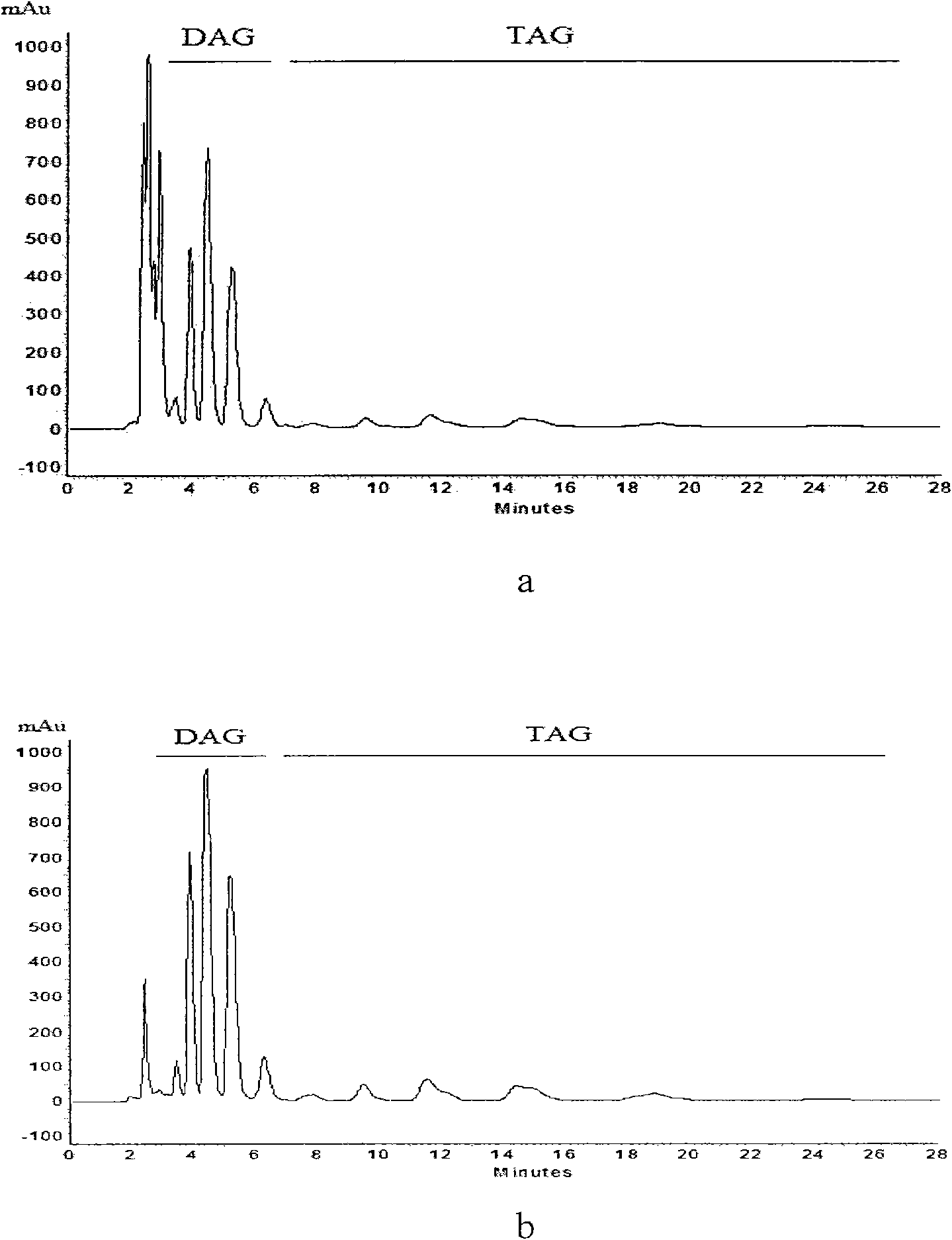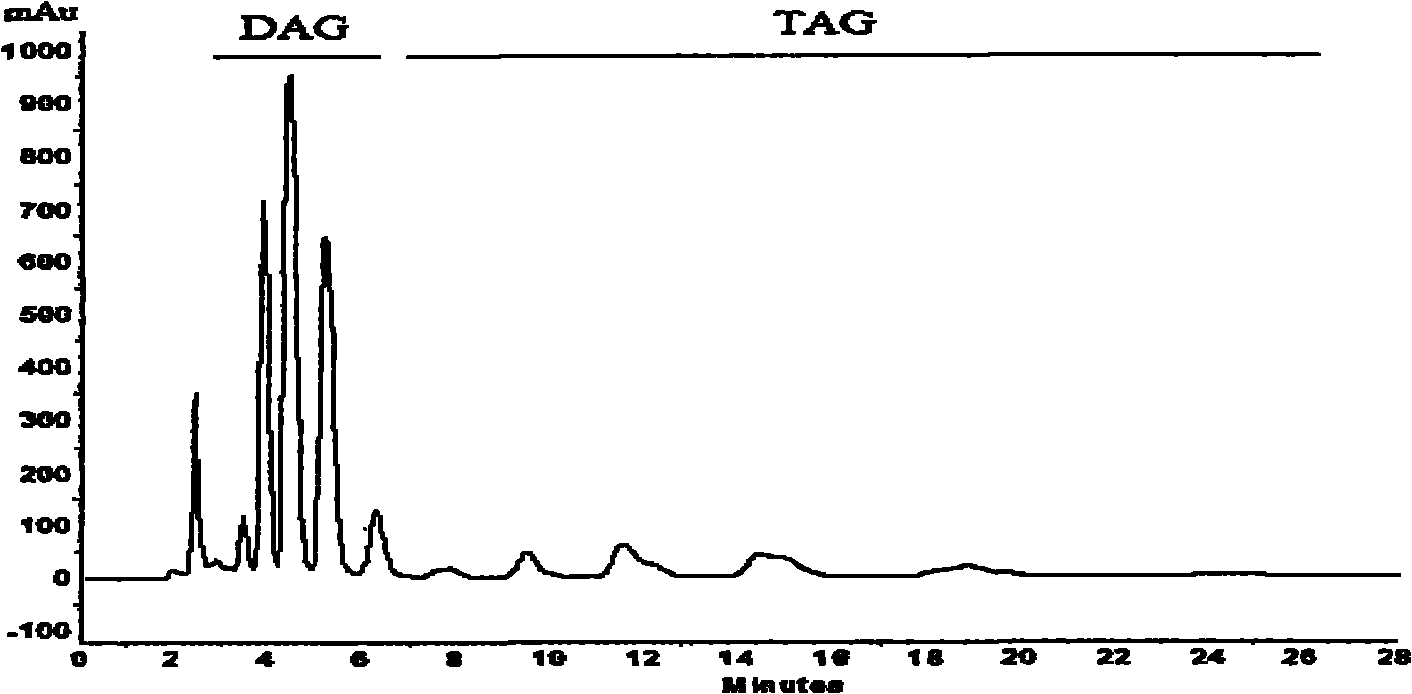Method for preparing diglyceride from phosphatidase A1 through catalytic esterification
A technology of diglyceride and catalyzed esterification, applied in the direction of fermentation, etc., to achieve the effect of cost advantage and good application prospect
- Summary
- Abstract
- Description
- Claims
- Application Information
AI Technical Summary
Problems solved by technology
Method used
Image
Examples
preparation example Construction
[0022] Preparation of reaction raw material fatty acid: Weigh 500.00g soybean oil in a 1000mL three-necked flask and react for 8h in a constant temperature water bath at 40℃ with a stirring speed of 300r / min to obtain a hydrolysate; the hydrolysate is allowed to stand for 30min to separate into two layers ; The upper layer is an oil layer containing glycerides and fatty acids. The oil layer is at 160°C and a pressure of 1.0 Pa to obtain hydrolyzed fatty acids (FFA) through molecular distillation.
[0023] The acid value of oil is determined according to GB / T 5530-1995 titration method.
[0024] The calculation method of the esterification rate is as follows: esterification rate=(initial fatty acid acid value-oil layer acid value after reaction) / initial fatty acid acid value×100%. HPLC method was used to determine the content of crude diglyceride and molecularly distilled diglyceride.
Embodiment 1
[0026] Put the fatty acid and glycerol molar ratio 0.5:1 in the sandwich beaker to obtain the substrate; add 80 U / g substrate phospholipase A1 (Lecitase Ultra) and the substrate mass 4.0wt% deionized water to the substrate in turn , The reaction temperature is controlled to 40℃ by super constant temperature water bath, and the magnetic stirrer is used to stir (rotation speed 300r / min). The reaction is carried out under vacuum (absolute pressure 400Pa), and the reaction time is 12h; after the enzymatic hydrolysis reaction is completed, the reaction solution is Centrifuge at 3000r / min for 10 minutes to separate layers, the lower layer is unreacted glycerin, and the upper layer is crude diglyceride (containing fatty acid impurities); the acid value of the upper layer is measured, the esterification rate is 43.87%, and the DAG content in the crude diglyceride is 12.78%.
[0027] The crude diglyceride layer obtained above is fed into a molecular distillation feed tank, and after dehyd...
Embodiment 2
[0029] Place the fatty acid and glycerol at a molar ratio of 2.21:1 in a sandwich beaker to obtain a substrate; add 90 U / g substrate phospholipase A1 (Lecitase Ultra) and a substrate mass of 4.0 wt% deionized water to the substrate in turn , The reaction temperature is controlled to 41 ℃ by super constant temperature water bath, and the magnetic stirrer is used to stir (rotation speed 300r / min). The reaction is carried out under vacuum (absolute pressure 2000Pa), and the reaction time is 12h; after the enzymatic hydrolysis reaction is completed, the reaction solution is Centrifuge at 3000r / min for 10 minutes to separate layers. The lower layer is unreacted glycerin, and the upper layer is crude diglyceride (containing fatty acid impurities); the acid value of the upper layer is measured, the esterification rate is 82.34%, and the DAG content in the crude diglyceride is 41.54%, the HPLC analysis chart is as figure 1 (a) Shown.
[0030] The crude diglyceride layer obtained above i...
PUM
 Login to View More
Login to View More Abstract
Description
Claims
Application Information
 Login to View More
Login to View More - R&D
- Intellectual Property
- Life Sciences
- Materials
- Tech Scout
- Unparalleled Data Quality
- Higher Quality Content
- 60% Fewer Hallucinations
Browse by: Latest US Patents, China's latest patents, Technical Efficacy Thesaurus, Application Domain, Technology Topic, Popular Technical Reports.
© 2025 PatSnap. All rights reserved.Legal|Privacy policy|Modern Slavery Act Transparency Statement|Sitemap|About US| Contact US: help@patsnap.com


